The Russian Revolution: Causes, Consequences and Analysis
VerifiedAdded on 2023/06/04
|10
|2196
|73
AI Summary
The Russian revolution brought about tremendous changes in the History of Russia. This write-up tends to unveil some of the reasons for its outbreak, its consequences and the chronology of events as they unfolded during the revolution. It's basically an analysis of the Russian revolution but in a much deeper context.
Contribute Materials
Your contribution can guide someone’s learning journey. Share your
documents today.
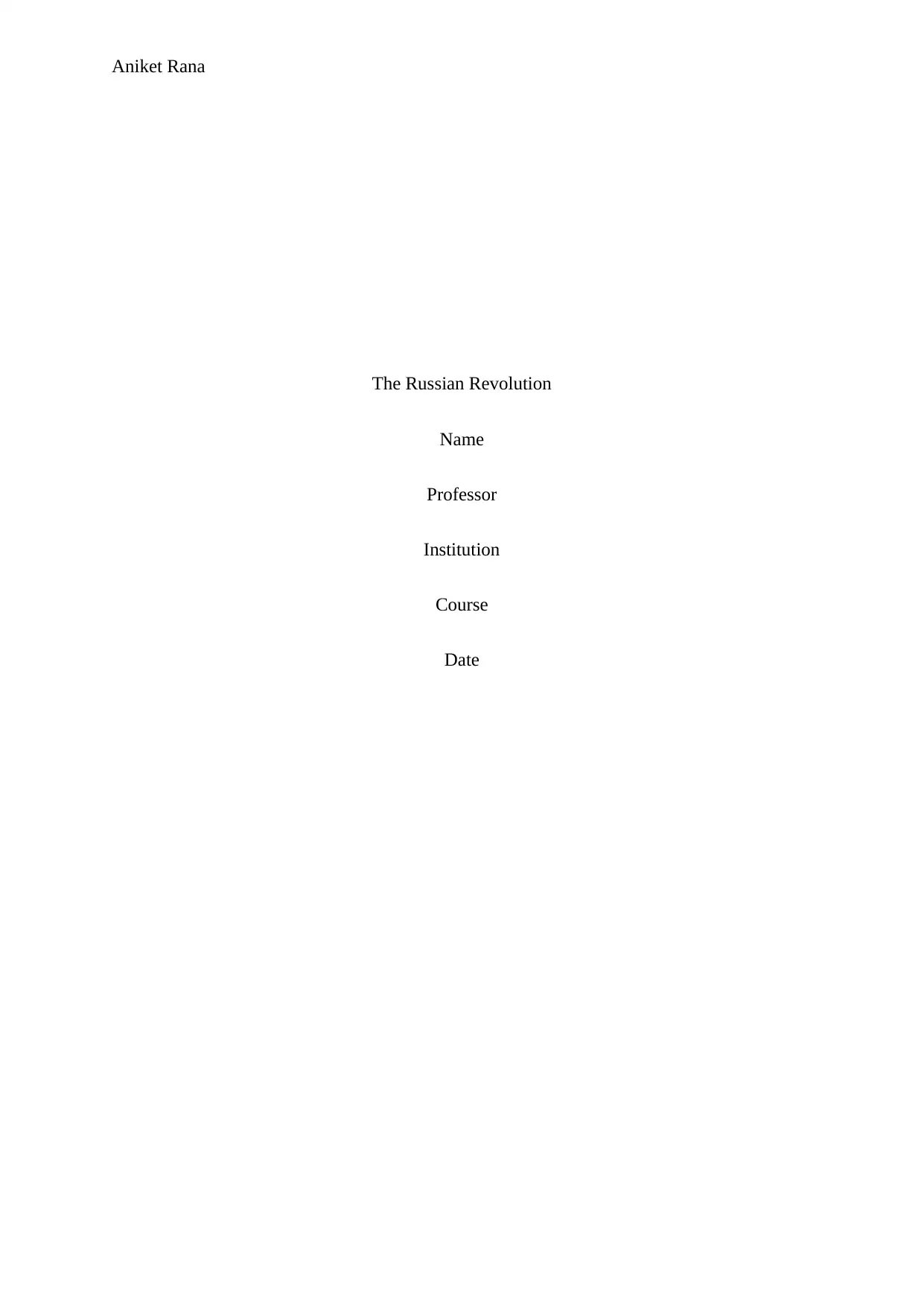
Aniket Rana
The Russian Revolution
Name
Professor
Institution
Course
Date
The Russian Revolution
Name
Professor
Institution
Course
Date
Secure Best Marks with AI Grader
Need help grading? Try our AI Grader for instant feedback on your assignments.
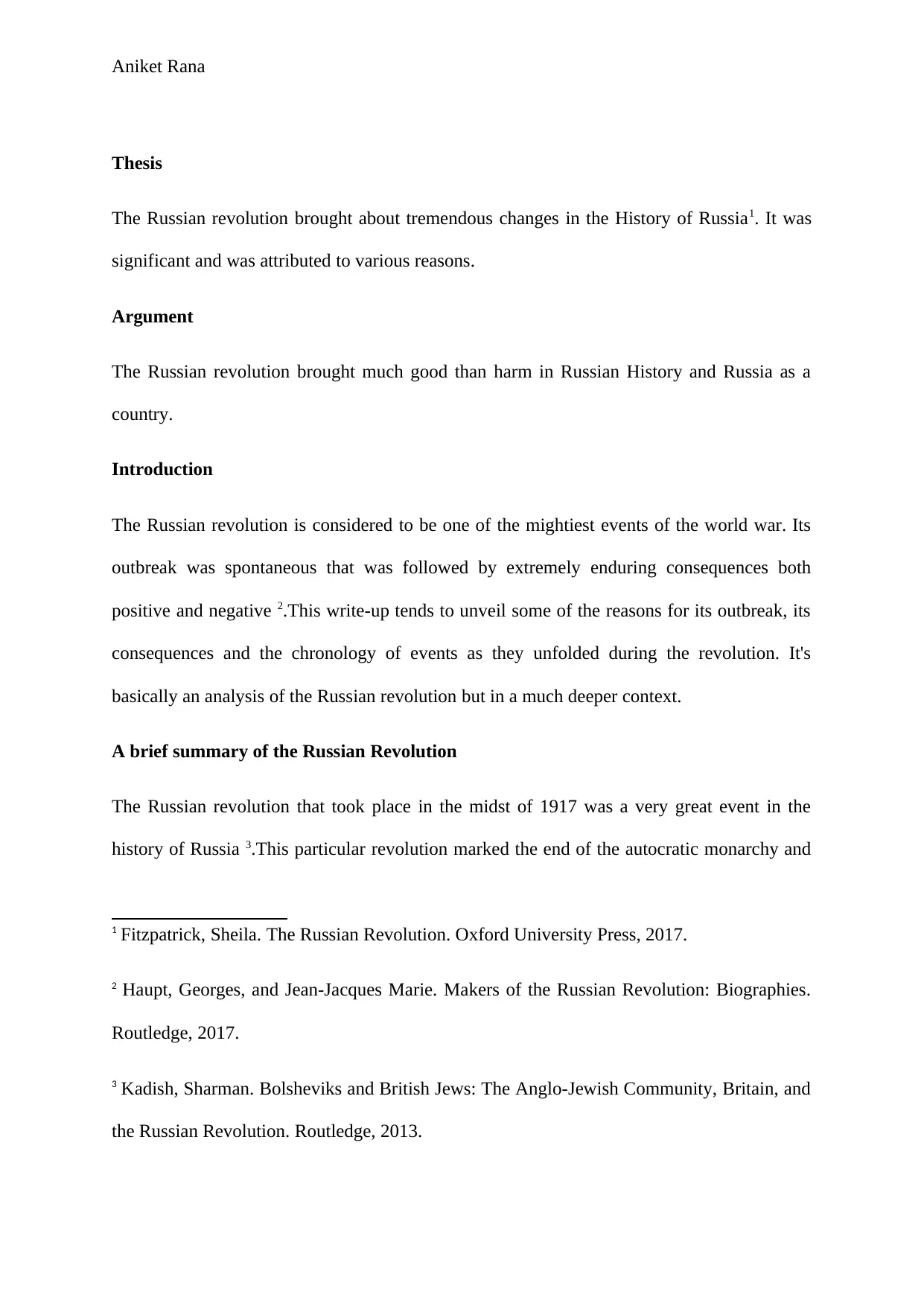
Aniket Rana
Thesis
The Russian revolution brought about tremendous changes in the History of Russia1. It was
significant and was attributed to various reasons.
Argument
The Russian revolution brought much good than harm in Russian History and Russia as a
country.
Introduction
The Russian revolution is considered to be one of the mightiest events of the world war. Its
outbreak was spontaneous that was followed by extremely enduring consequences both
positive and negative 2.This write-up tends to unveil some of the reasons for its outbreak, its
consequences and the chronology of events as they unfolded during the revolution. It's
basically an analysis of the Russian revolution but in a much deeper context.
A brief summary of the Russian Revolution
The Russian revolution that took place in the midst of 1917 was a very great event in the
history of Russia 3.This particular revolution marked the end of the autocratic monarchy and
1 Fitzpatrick, Sheila. The Russian Revolution. Oxford University Press, 2017.
2 Haupt, Georges, and Jean-Jacques Marie. Makers of the Russian Revolution: Biographies.
Routledge, 2017.
3 Kadish, Sharman. Bolsheviks and British Jews: The Anglo-Jewish Community, Britain, and
the Russian Revolution. Routledge, 2013.
Thesis
The Russian revolution brought about tremendous changes in the History of Russia1. It was
significant and was attributed to various reasons.
Argument
The Russian revolution brought much good than harm in Russian History and Russia as a
country.
Introduction
The Russian revolution is considered to be one of the mightiest events of the world war. Its
outbreak was spontaneous that was followed by extremely enduring consequences both
positive and negative 2.This write-up tends to unveil some of the reasons for its outbreak, its
consequences and the chronology of events as they unfolded during the revolution. It's
basically an analysis of the Russian revolution but in a much deeper context.
A brief summary of the Russian Revolution
The Russian revolution that took place in the midst of 1917 was a very great event in the
history of Russia 3.This particular revolution marked the end of the autocratic monarchy and
1 Fitzpatrick, Sheila. The Russian Revolution. Oxford University Press, 2017.
2 Haupt, Georges, and Jean-Jacques Marie. Makers of the Russian Revolution: Biographies.
Routledge, 2017.
3 Kadish, Sharman. Bolsheviks and British Jews: The Anglo-Jewish Community, Britain, and
the Russian Revolution. Routledge, 2013.
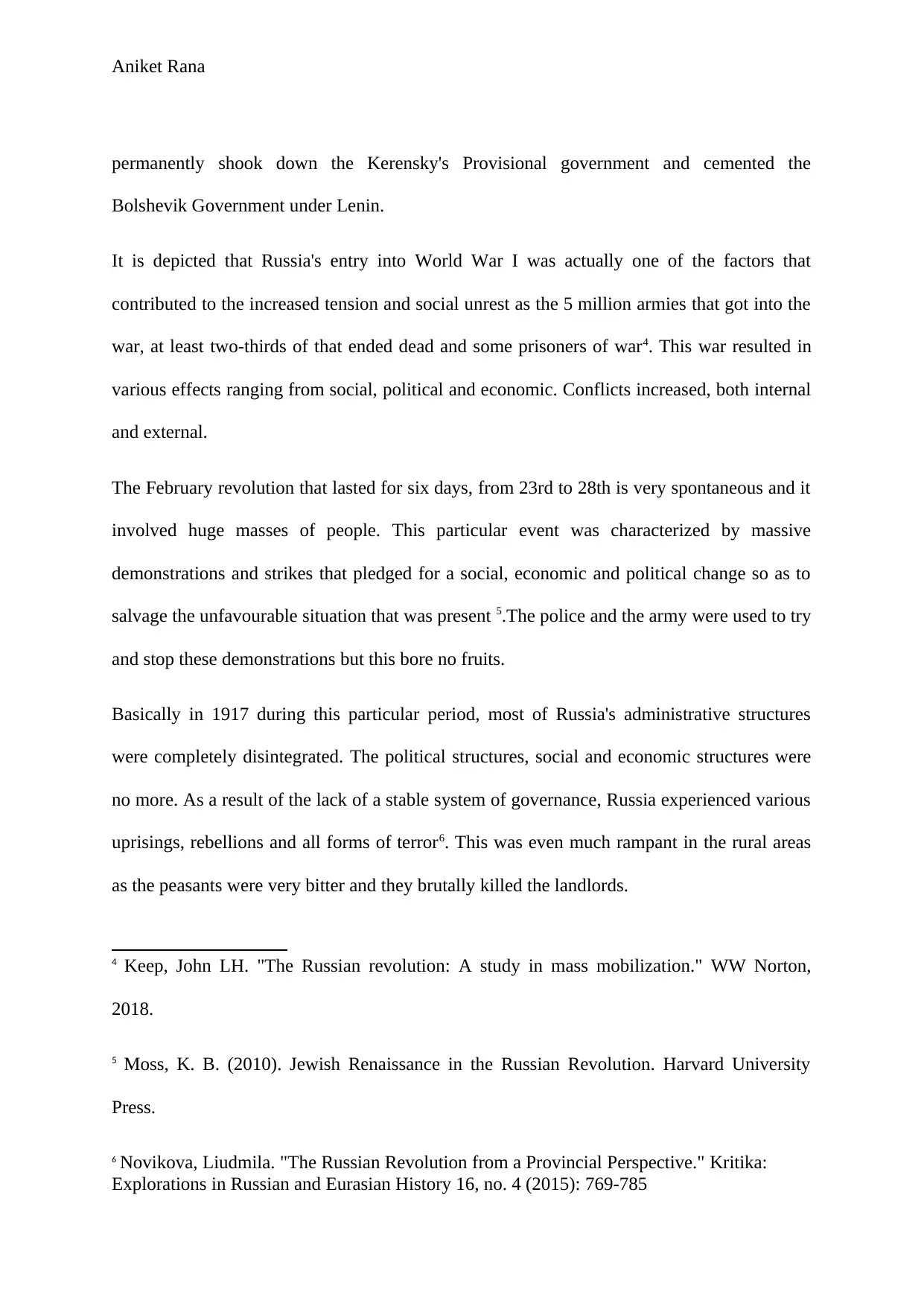
Aniket Rana
permanently shook down the Kerensky's Provisional government and cemented the
Bolshevik Government under Lenin.
It is depicted that Russia's entry into World War I was actually one of the factors that
contributed to the increased tension and social unrest as the 5 million armies that got into the
war, at least two-thirds of that ended dead and some prisoners of war4. This war resulted in
various effects ranging from social, political and economic. Conflicts increased, both internal
and external.
The February revolution that lasted for six days, from 23rd to 28th is very spontaneous and it
involved huge masses of people. This particular event was characterized by massive
demonstrations and strikes that pledged for a social, economic and political change so as to
salvage the unfavourable situation that was present 5.The police and the army were used to try
and stop these demonstrations but this bore no fruits.
Basically in 1917 during this particular period, most of Russia's administrative structures
were completely disintegrated. The political structures, social and economic structures were
no more. As a result of the lack of a stable system of governance, Russia experienced various
uprisings, rebellions and all forms of terror6. This was even much rampant in the rural areas
as the peasants were very bitter and they brutally killed the landlords.
4 Keep, John LH. "The Russian revolution: A study in mass mobilization." WW Norton,
2018.
5 Moss, K. B. (2010). Jewish Renaissance in the Russian Revolution. Harvard University
Press.
6 Novikova, Liudmila. "The Russian Revolution from a Provincial Perspective." Kritika:
Explorations in Russian and Eurasian History 16, no. 4 (2015): 769-785
permanently shook down the Kerensky's Provisional government and cemented the
Bolshevik Government under Lenin.
It is depicted that Russia's entry into World War I was actually one of the factors that
contributed to the increased tension and social unrest as the 5 million armies that got into the
war, at least two-thirds of that ended dead and some prisoners of war4. This war resulted in
various effects ranging from social, political and economic. Conflicts increased, both internal
and external.
The February revolution that lasted for six days, from 23rd to 28th is very spontaneous and it
involved huge masses of people. This particular event was characterized by massive
demonstrations and strikes that pledged for a social, economic and political change so as to
salvage the unfavourable situation that was present 5.The police and the army were used to try
and stop these demonstrations but this bore no fruits.
Basically in 1917 during this particular period, most of Russia's administrative structures
were completely disintegrated. The political structures, social and economic structures were
no more. As a result of the lack of a stable system of governance, Russia experienced various
uprisings, rebellions and all forms of terror6. This was even much rampant in the rural areas
as the peasants were very bitter and they brutally killed the landlords.
4 Keep, John LH. "The Russian revolution: A study in mass mobilization." WW Norton,
2018.
5 Moss, K. B. (2010). Jewish Renaissance in the Russian Revolution. Harvard University
Press.
6 Novikova, Liudmila. "The Russian Revolution from a Provincial Perspective." Kritika:
Explorations in Russian and Eurasian History 16, no. 4 (2015): 769-785
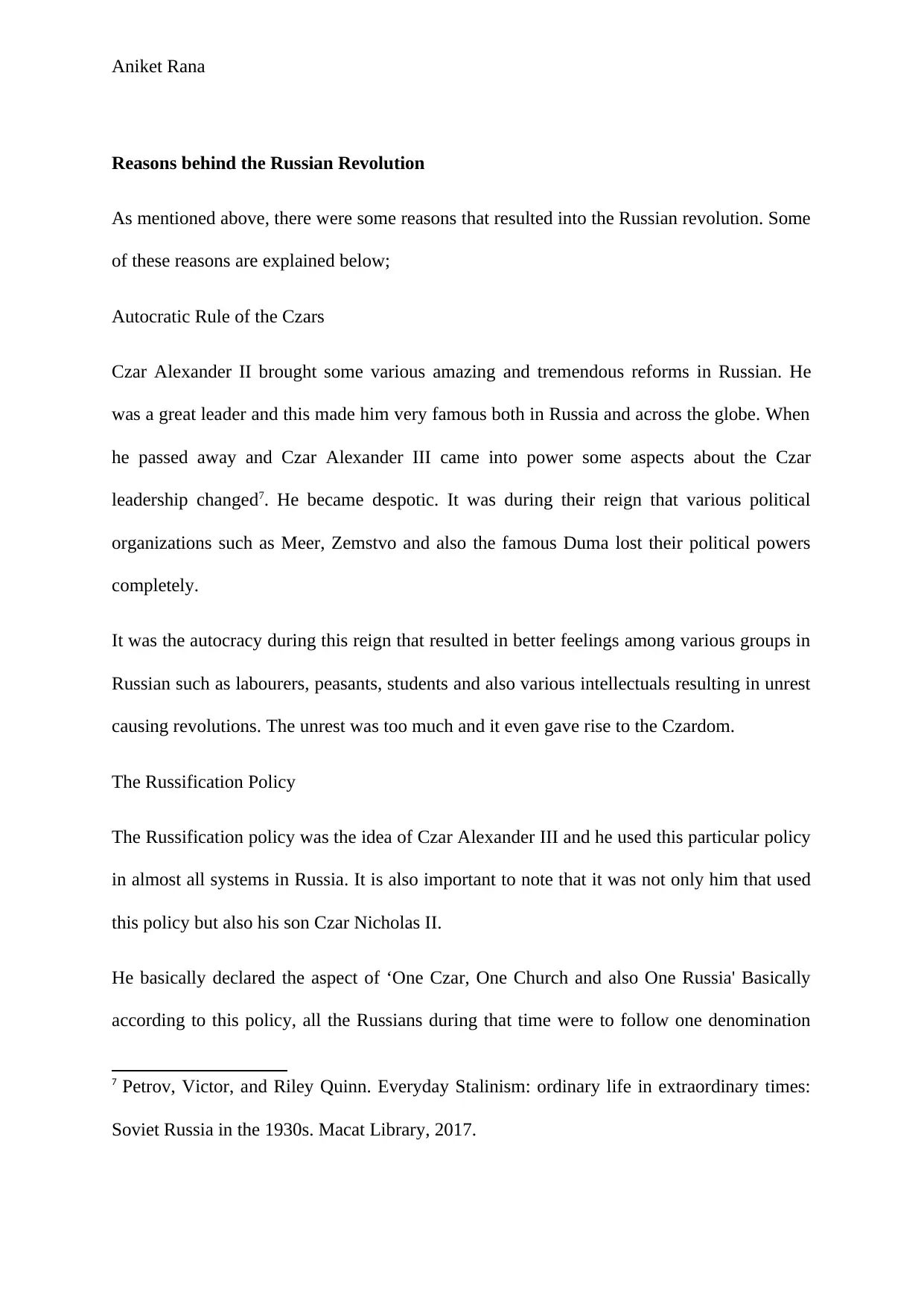
Aniket Rana
Reasons behind the Russian Revolution
As mentioned above, there were some reasons that resulted into the Russian revolution. Some
of these reasons are explained below;
Autocratic Rule of the Czars
Czar Alexander II brought some various amazing and tremendous reforms in Russian. He
was a great leader and this made him very famous both in Russia and across the globe. When
he passed away and Czar Alexander III came into power some aspects about the Czar
leadership changed7. He became despotic. It was during their reign that various political
organizations such as Meer, Zemstvo and also the famous Duma lost their political powers
completely.
It was the autocracy during this reign that resulted in better feelings among various groups in
Russian such as labourers, peasants, students and also various intellectuals resulting in unrest
causing revolutions. The unrest was too much and it even gave rise to the Czardom.
The Russification Policy
The Russification policy was the idea of Czar Alexander III and he used this particular policy
in almost all systems in Russia. It is also important to note that it was not only him that used
this policy but also his son Czar Nicholas II.
He basically declared the aspect of ‘One Czar, One Church and also One Russia' Basically
according to this policy, all the Russians during that time were to follow one denomination
7 Petrov, Victor, and Riley Quinn. Everyday Stalinism: ordinary life in extraordinary times:
Soviet Russia in the 1930s. Macat Library, 2017.
Reasons behind the Russian Revolution
As mentioned above, there were some reasons that resulted into the Russian revolution. Some
of these reasons are explained below;
Autocratic Rule of the Czars
Czar Alexander II brought some various amazing and tremendous reforms in Russian. He
was a great leader and this made him very famous both in Russia and across the globe. When
he passed away and Czar Alexander III came into power some aspects about the Czar
leadership changed7. He became despotic. It was during their reign that various political
organizations such as Meer, Zemstvo and also the famous Duma lost their political powers
completely.
It was the autocracy during this reign that resulted in better feelings among various groups in
Russian such as labourers, peasants, students and also various intellectuals resulting in unrest
causing revolutions. The unrest was too much and it even gave rise to the Czardom.
The Russification Policy
The Russification policy was the idea of Czar Alexander III and he used this particular policy
in almost all systems in Russia. It is also important to note that it was not only him that used
this policy but also his son Czar Nicholas II.
He basically declared the aspect of ‘One Czar, One Church and also One Russia' Basically
according to this policy, all the Russians during that time were to follow one denomination
7 Petrov, Victor, and Riley Quinn. Everyday Stalinism: ordinary life in extraordinary times:
Soviet Russia in the 1930s. Macat Library, 2017.
Secure Best Marks with AI Grader
Need help grading? Try our AI Grader for instant feedback on your assignments.
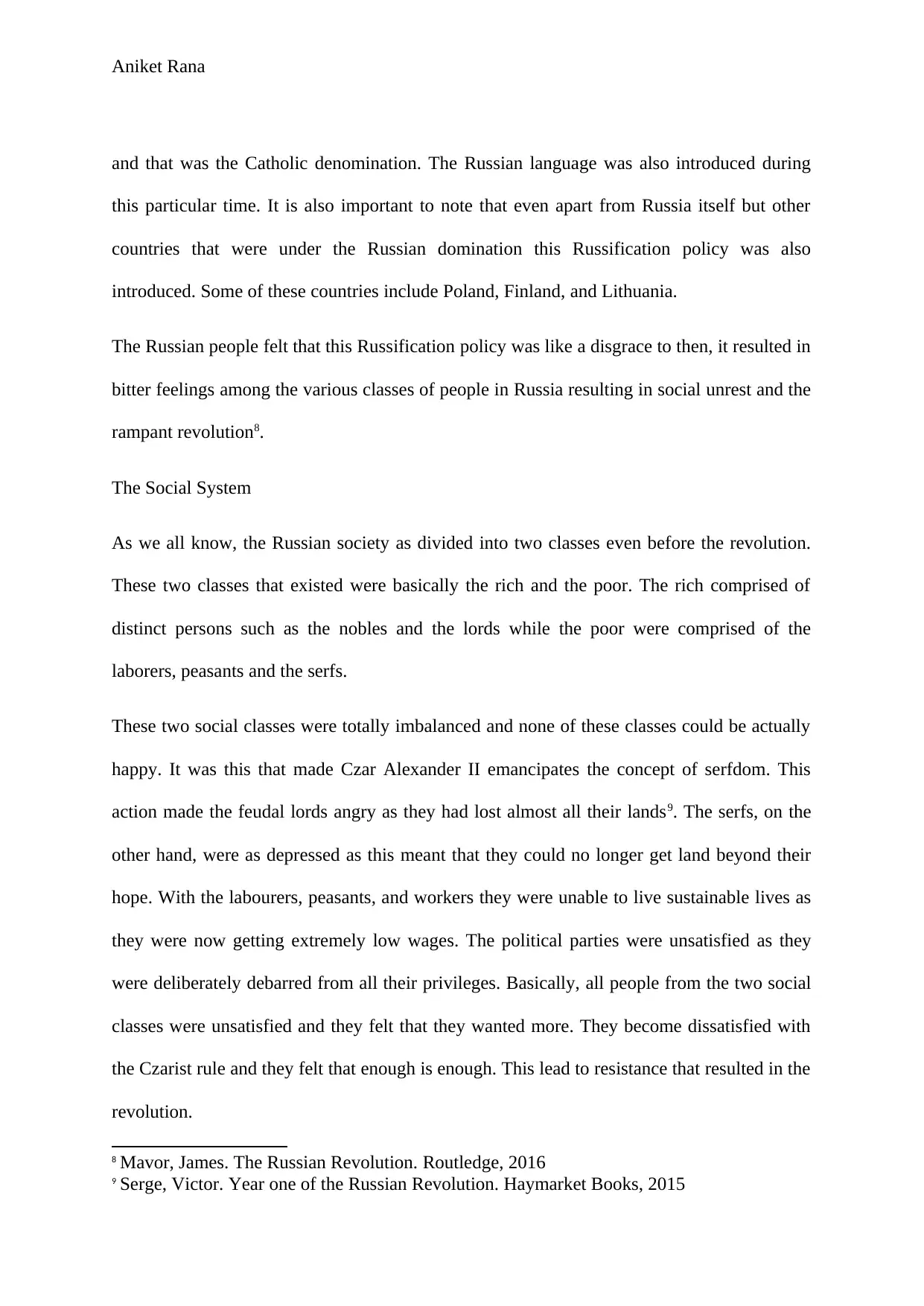
Aniket Rana
and that was the Catholic denomination. The Russian language was also introduced during
this particular time. It is also important to note that even apart from Russia itself but other
countries that were under the Russian domination this Russification policy was also
introduced. Some of these countries include Poland, Finland, and Lithuania.
The Russian people felt that this Russification policy was like a disgrace to then, it resulted in
bitter feelings among the various classes of people in Russia resulting in social unrest and the
rampant revolution8.
The Social System
As we all know, the Russian society as divided into two classes even before the revolution.
These two classes that existed were basically the rich and the poor. The rich comprised of
distinct persons such as the nobles and the lords while the poor were comprised of the
laborers, peasants and the serfs.
These two social classes were totally imbalanced and none of these classes could be actually
happy. It was this that made Czar Alexander II emancipates the concept of serfdom. This
action made the feudal lords angry as they had lost almost all their lands9. The serfs, on the
other hand, were as depressed as this meant that they could no longer get land beyond their
hope. With the labourers, peasants, and workers they were unable to live sustainable lives as
they were now getting extremely low wages. The political parties were unsatisfied as they
were deliberately debarred from all their privileges. Basically, all people from the two social
classes were unsatisfied and they felt that they wanted more. They become dissatisfied with
the Czarist rule and they felt that enough is enough. This lead to resistance that resulted in the
revolution.
8 Mavor, James. The Russian Revolution. Routledge, 2016
9 Serge, Victor. Year one of the Russian Revolution. Haymarket Books, 2015
and that was the Catholic denomination. The Russian language was also introduced during
this particular time. It is also important to note that even apart from Russia itself but other
countries that were under the Russian domination this Russification policy was also
introduced. Some of these countries include Poland, Finland, and Lithuania.
The Russian people felt that this Russification policy was like a disgrace to then, it resulted in
bitter feelings among the various classes of people in Russia resulting in social unrest and the
rampant revolution8.
The Social System
As we all know, the Russian society as divided into two classes even before the revolution.
These two classes that existed were basically the rich and the poor. The rich comprised of
distinct persons such as the nobles and the lords while the poor were comprised of the
laborers, peasants and the serfs.
These two social classes were totally imbalanced and none of these classes could be actually
happy. It was this that made Czar Alexander II emancipates the concept of serfdom. This
action made the feudal lords angry as they had lost almost all their lands9. The serfs, on the
other hand, were as depressed as this meant that they could no longer get land beyond their
hope. With the labourers, peasants, and workers they were unable to live sustainable lives as
they were now getting extremely low wages. The political parties were unsatisfied as they
were deliberately debarred from all their privileges. Basically, all people from the two social
classes were unsatisfied and they felt that they wanted more. They become dissatisfied with
the Czarist rule and they felt that enough is enough. This lead to resistance that resulted in the
revolution.
8 Mavor, James. The Russian Revolution. Routledge, 2016
9 Serge, Victor. Year one of the Russian Revolution. Haymarket Books, 2015
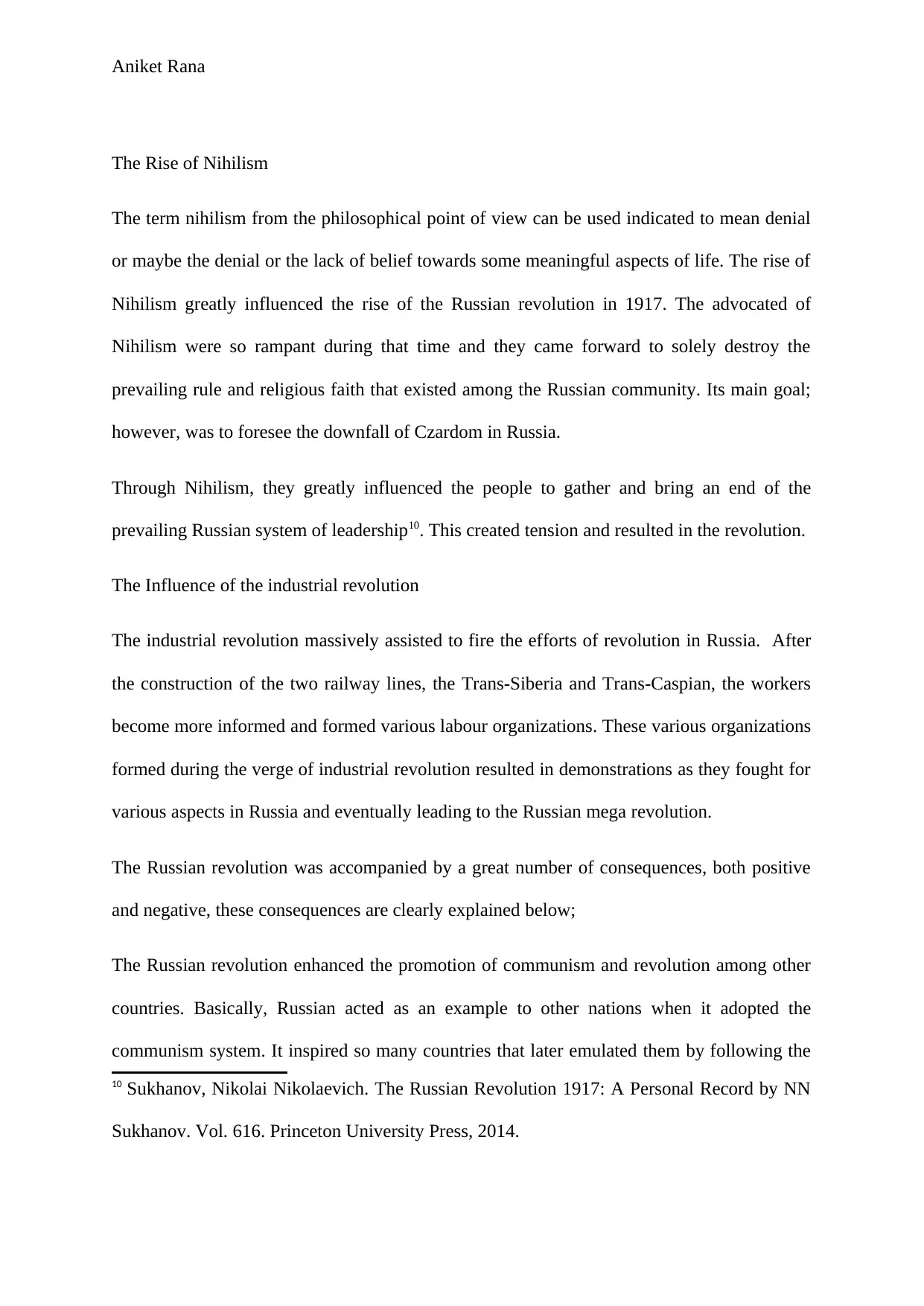
Aniket Rana
The Rise of Nihilism
The term nihilism from the philosophical point of view can be used indicated to mean denial
or maybe the denial or the lack of belief towards some meaningful aspects of life. The rise of
Nihilism greatly influenced the rise of the Russian revolution in 1917. The advocated of
Nihilism were so rampant during that time and they came forward to solely destroy the
prevailing rule and religious faith that existed among the Russian community. Its main goal;
however, was to foresee the downfall of Czardom in Russia.
Through Nihilism, they greatly influenced the people to gather and bring an end of the
prevailing Russian system of leadership10. This created tension and resulted in the revolution.
The Influence of the industrial revolution
The industrial revolution massively assisted to fire the efforts of revolution in Russia. After
the construction of the two railway lines, the Trans-Siberia and Trans-Caspian, the workers
become more informed and formed various labour organizations. These various organizations
formed during the verge of industrial revolution resulted in demonstrations as they fought for
various aspects in Russia and eventually leading to the Russian mega revolution.
The Russian revolution was accompanied by a great number of consequences, both positive
and negative, these consequences are clearly explained below;
The Russian revolution enhanced the promotion of communism and revolution among other
countries. Basically, Russian acted as an example to other nations when it adopted the
communism system. It inspired so many countries that later emulated them by following the
10 Sukhanov, Nikolai Nikolaevich. The Russian Revolution 1917: A Personal Record by NN
Sukhanov. Vol. 616. Princeton University Press, 2014.
The Rise of Nihilism
The term nihilism from the philosophical point of view can be used indicated to mean denial
or maybe the denial or the lack of belief towards some meaningful aspects of life. The rise of
Nihilism greatly influenced the rise of the Russian revolution in 1917. The advocated of
Nihilism were so rampant during that time and they came forward to solely destroy the
prevailing rule and religious faith that existed among the Russian community. Its main goal;
however, was to foresee the downfall of Czardom in Russia.
Through Nihilism, they greatly influenced the people to gather and bring an end of the
prevailing Russian system of leadership10. This created tension and resulted in the revolution.
The Influence of the industrial revolution
The industrial revolution massively assisted to fire the efforts of revolution in Russia. After
the construction of the two railway lines, the Trans-Siberia and Trans-Caspian, the workers
become more informed and formed various labour organizations. These various organizations
formed during the verge of industrial revolution resulted in demonstrations as they fought for
various aspects in Russia and eventually leading to the Russian mega revolution.
The Russian revolution was accompanied by a great number of consequences, both positive
and negative, these consequences are clearly explained below;
The Russian revolution enhanced the promotion of communism and revolution among other
countries. Basically, Russian acted as an example to other nations when it adopted the
communism system. It inspired so many countries that later emulated them by following the
10 Sukhanov, Nikolai Nikolaevich. The Russian Revolution 1917: A Personal Record by NN
Sukhanov. Vol. 616. Princeton University Press, 2014.
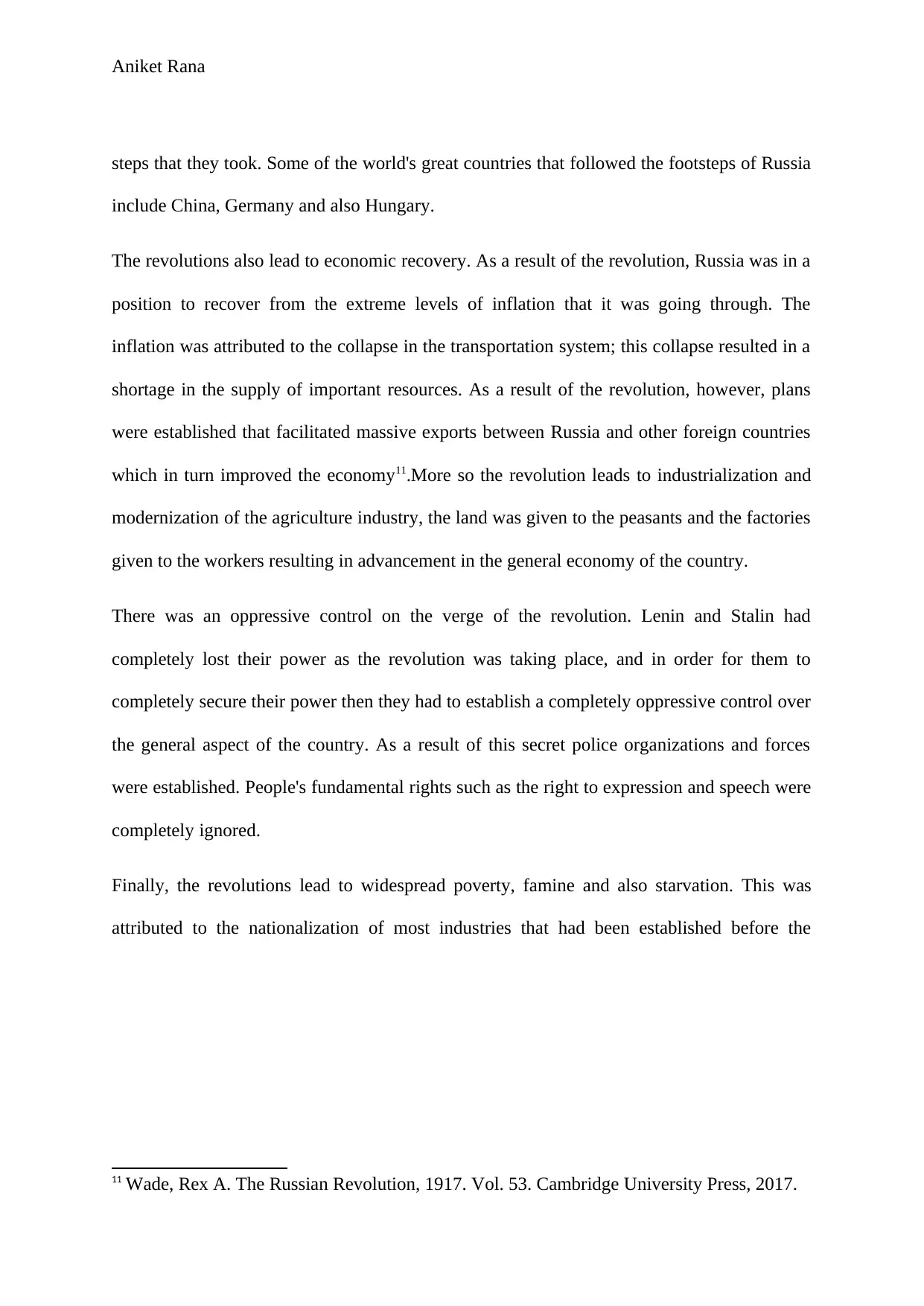
Aniket Rana
steps that they took. Some of the world's great countries that followed the footsteps of Russia
include China, Germany and also Hungary.
The revolutions also lead to economic recovery. As a result of the revolution, Russia was in a
position to recover from the extreme levels of inflation that it was going through. The
inflation was attributed to the collapse in the transportation system; this collapse resulted in a
shortage in the supply of important resources. As a result of the revolution, however, plans
were established that facilitated massive exports between Russia and other foreign countries
which in turn improved the economy11.More so the revolution leads to industrialization and
modernization of the agriculture industry, the land was given to the peasants and the factories
given to the workers resulting in advancement in the general economy of the country.
There was an oppressive control on the verge of the revolution. Lenin and Stalin had
completely lost their power as the revolution was taking place, and in order for them to
completely secure their power then they had to establish a completely oppressive control over
the general aspect of the country. As a result of this secret police organizations and forces
were established. People's fundamental rights such as the right to expression and speech were
completely ignored.
Finally, the revolutions lead to widespread poverty, famine and also starvation. This was
attributed to the nationalization of most industries that had been established before the
11 Wade, Rex A. The Russian Revolution, 1917. Vol. 53. Cambridge University Press, 2017.
steps that they took. Some of the world's great countries that followed the footsteps of Russia
include China, Germany and also Hungary.
The revolutions also lead to economic recovery. As a result of the revolution, Russia was in a
position to recover from the extreme levels of inflation that it was going through. The
inflation was attributed to the collapse in the transportation system; this collapse resulted in a
shortage in the supply of important resources. As a result of the revolution, however, plans
were established that facilitated massive exports between Russia and other foreign countries
which in turn improved the economy11.More so the revolution leads to industrialization and
modernization of the agriculture industry, the land was given to the peasants and the factories
given to the workers resulting in advancement in the general economy of the country.
There was an oppressive control on the verge of the revolution. Lenin and Stalin had
completely lost their power as the revolution was taking place, and in order for them to
completely secure their power then they had to establish a completely oppressive control over
the general aspect of the country. As a result of this secret police organizations and forces
were established. People's fundamental rights such as the right to expression and speech were
completely ignored.
Finally, the revolutions lead to widespread poverty, famine and also starvation. This was
attributed to the nationalization of most industries that had been established before the
11 Wade, Rex A. The Russian Revolution, 1917. Vol. 53. Cambridge University Press, 2017.
Paraphrase This Document
Need a fresh take? Get an instant paraphrase of this document with our AI Paraphraser
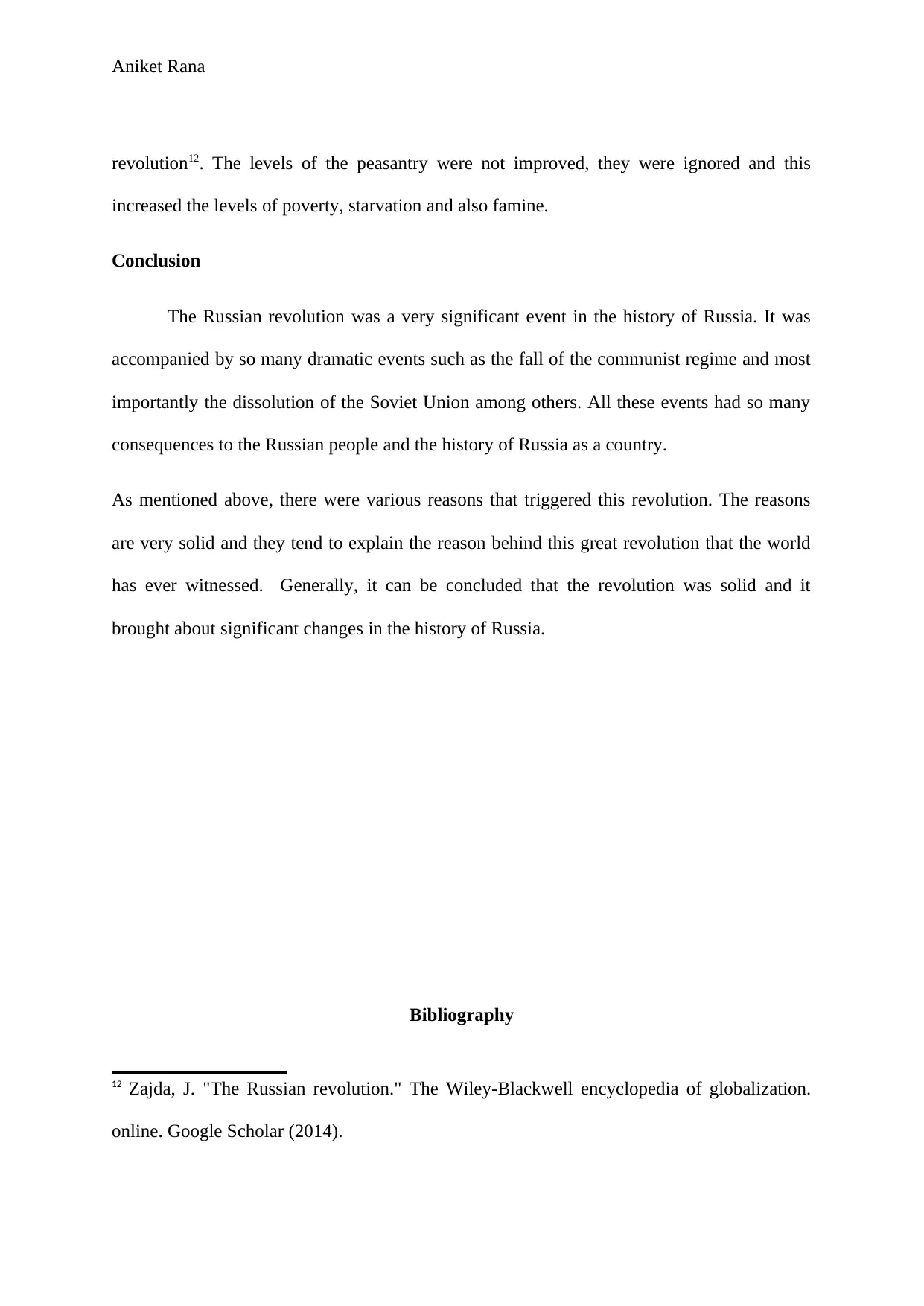
Aniket Rana
revolution12. The levels of the peasantry were not improved, they were ignored and this
increased the levels of poverty, starvation and also famine.
Conclusion
The Russian revolution was a very significant event in the history of Russia. It was
accompanied by so many dramatic events such as the fall of the communist regime and most
importantly the dissolution of the Soviet Union among others. All these events had so many
consequences to the Russian people and the history of Russia as a country.
As mentioned above, there were various reasons that triggered this revolution. The reasons
are very solid and they tend to explain the reason behind this great revolution that the world
has ever witnessed. Generally, it can be concluded that the revolution was solid and it
brought about significant changes in the history of Russia.
Bibliography
12 Zajda, J. "The Russian revolution." The Wiley-Blackwell encyclopedia of globalization.
online. Google Scholar (2014).
revolution12. The levels of the peasantry were not improved, they were ignored and this
increased the levels of poverty, starvation and also famine.
Conclusion
The Russian revolution was a very significant event in the history of Russia. It was
accompanied by so many dramatic events such as the fall of the communist regime and most
importantly the dissolution of the Soviet Union among others. All these events had so many
consequences to the Russian people and the history of Russia as a country.
As mentioned above, there were various reasons that triggered this revolution. The reasons
are very solid and they tend to explain the reason behind this great revolution that the world
has ever witnessed. Generally, it can be concluded that the revolution was solid and it
brought about significant changes in the history of Russia.
Bibliography
12 Zajda, J. "The Russian revolution." The Wiley-Blackwell encyclopedia of globalization.
online. Google Scholar (2014).
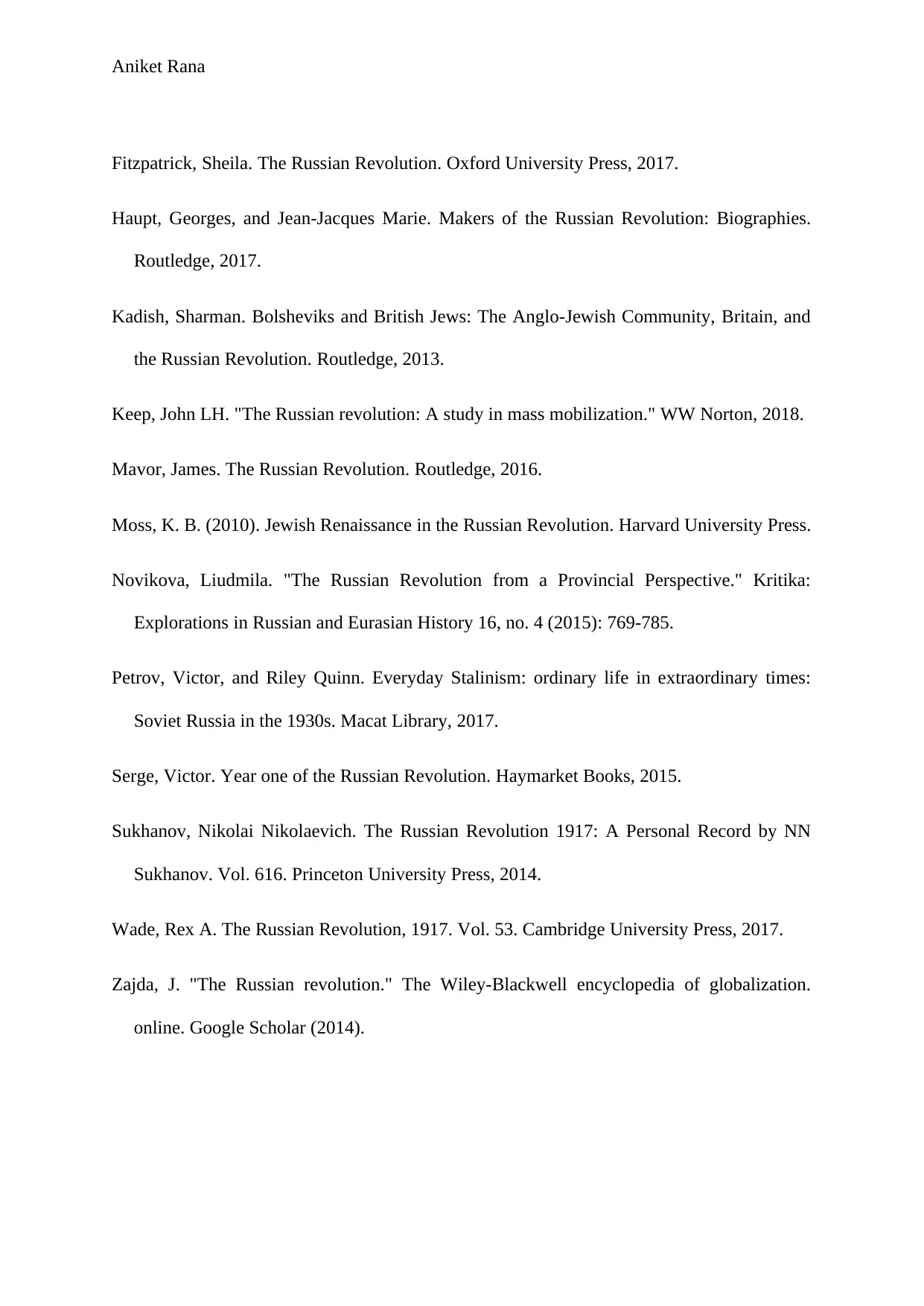
Aniket Rana
Fitzpatrick, Sheila. The Russian Revolution. Oxford University Press, 2017.
Haupt, Georges, and Jean-Jacques Marie. Makers of the Russian Revolution: Biographies.
Routledge, 2017.
Kadish, Sharman. Bolsheviks and British Jews: The Anglo-Jewish Community, Britain, and
the Russian Revolution. Routledge, 2013.
Keep, John LH. "The Russian revolution: A study in mass mobilization." WW Norton, 2018.
Mavor, James. The Russian Revolution. Routledge, 2016.
Moss, K. B. (2010). Jewish Renaissance in the Russian Revolution. Harvard University Press.
Novikova, Liudmila. "The Russian Revolution from a Provincial Perspective." Kritika:
Explorations in Russian and Eurasian History 16, no. 4 (2015): 769-785.
Petrov, Victor, and Riley Quinn. Everyday Stalinism: ordinary life in extraordinary times:
Soviet Russia in the 1930s. Macat Library, 2017.
Serge, Victor. Year one of the Russian Revolution. Haymarket Books, 2015.
Sukhanov, Nikolai Nikolaevich. The Russian Revolution 1917: A Personal Record by NN
Sukhanov. Vol. 616. Princeton University Press, 2014.
Wade, Rex A. The Russian Revolution, 1917. Vol. 53. Cambridge University Press, 2017.
Zajda, J. "The Russian revolution." The Wiley-Blackwell encyclopedia of globalization.
online. Google Scholar (2014).
Fitzpatrick, Sheila. The Russian Revolution. Oxford University Press, 2017.
Haupt, Georges, and Jean-Jacques Marie. Makers of the Russian Revolution: Biographies.
Routledge, 2017.
Kadish, Sharman. Bolsheviks and British Jews: The Anglo-Jewish Community, Britain, and
the Russian Revolution. Routledge, 2013.
Keep, John LH. "The Russian revolution: A study in mass mobilization." WW Norton, 2018.
Mavor, James. The Russian Revolution. Routledge, 2016.
Moss, K. B. (2010). Jewish Renaissance in the Russian Revolution. Harvard University Press.
Novikova, Liudmila. "The Russian Revolution from a Provincial Perspective." Kritika:
Explorations in Russian and Eurasian History 16, no. 4 (2015): 769-785.
Petrov, Victor, and Riley Quinn. Everyday Stalinism: ordinary life in extraordinary times:
Soviet Russia in the 1930s. Macat Library, 2017.
Serge, Victor. Year one of the Russian Revolution. Haymarket Books, 2015.
Sukhanov, Nikolai Nikolaevich. The Russian Revolution 1917: A Personal Record by NN
Sukhanov. Vol. 616. Princeton University Press, 2014.
Wade, Rex A. The Russian Revolution, 1917. Vol. 53. Cambridge University Press, 2017.
Zajda, J. "The Russian revolution." The Wiley-Blackwell encyclopedia of globalization.
online. Google Scholar (2014).

Aniket Rana
1 out of 10
Your All-in-One AI-Powered Toolkit for Academic Success.
+13062052269
info@desklib.com
Available 24*7 on WhatsApp / Email
![[object Object]](/_next/static/media/star-bottom.7253800d.svg)
Unlock your academic potential
© 2024 | Zucol Services PVT LTD | All rights reserved.

